Fanorona Chess
Peter Aronson
Introduction
Fanorona Chess is a Chess variant played on the
on the double Alquerque
board usually used for the Malagasy game of
Fanorona,
with the forms of capture also taken from Fanorona: that
is, pieces capture by approach and withdrawal, but not both in the
same move. However, unlike in Fanorona, only the first piece in a
line is captured, not the entire line. If you move in such a way as
a piece or pieces can be captured, you must capture a piece.
Board and Setup
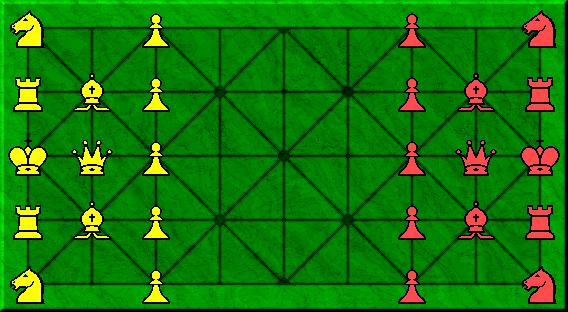

The board is 5x9 with only every other square (a1, a3, a5, b2, b4, etc.) having diagonal connectivity. Yellow pieces occupy the first row, and are ordered: Knight, Rook, King, Rook, Knight. On the second row, there are more Yellow pieces, ordered empty space, Bishop, Queen, Bishop, then an empty space again. Yellow Pawns occupy all of the third row. Red pieces occupy the ninth and eighth rows in the same order as the Yellow pieces occupy the first and second rows and Red pawns occupy the seventh row.
General Rules
The rules of Fanorona Chess are identical to those of FIDE Chess, except where noted otherwise below. The most general changes are that captures are by approach and withdrawal instead by replacement and that stalemate is a loss for the stalemated player rather than a draw.Movement of Pieces
The most important difference in movement from Chess played on a regular chess board is that half of the points on the board have no diagonal connecting lines. Such points can not be entered or exited by a diagonal move. All moves, even the Knight's, must follow the connecting lines.Kings, Queens, Rooks and Bishops move as they do in FIDE Chess, with the additional constraints provided by the board. Additionally, there is no castling, but Kings may make a noncapturing Knight's move as their first move if they are not in check at the time.
Unlike in FIDE Chess, the Knight follows a path when it moves. If it starts on a space with diagonal connecting lines, it first moves one step diagonally, then one step orthogonally outward. If it starts on a space without diagonally connecting lines, it first moves one step orthogonally, then one step diagonally outward. The first space may be occupied by a piece of either side. The directions of movement matter for capturing, but it should be noted that a Knight may move to any unoccupied space a Knight may move to in FIDE Chess.
The Pawn moves one step forward or (when possible) diagonally forward. There is no additional double-step for their first move, and thus no en-passant capture. If a Pawn reaches the far rank, it promotes, changing into any piece previously lost by that player. If there are no pieces to promote to, the Pawn may not enter the back row.
Capturing
Capturing is by withdrawal and by approach instead of FIDE Chess' usual method of capture by replacement. It is never possible in Fanorona Chess to move into an occupied square. Capture by approach and capture by withdrawal may not both occur as the result of a single move -- one form of capture must be selected. If a piece moves in such a way as so that it could capture, one of its possible captures must be made. However, a piece is not required to move in such a way as to capture if noncapturing moves are available (aside from any need to lift check).Capture by withdrawal occurs when a piece is adjacent to an opposing piece, and moves away from it in the same line.
Capture by approach occurs when a piece is moved next to an opposing piece in the same line as the movement.
Some examples of a Pawn's possible and not possible captures:
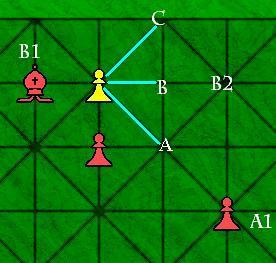
The Yellow Pawn could capture the Red Pawn at A1 by approach by moving to A, and could capture the Red Bishop at B1 by withdrawal by moving to B. Moving to C would not capture anything. If there was an opposing piece at B2, then a move to B would be required to capture it or the Bishop at B1, but could not capture both, and the Yellow player would decide which piece was captured.
Some examples of a Knight's possible and not possible captures:
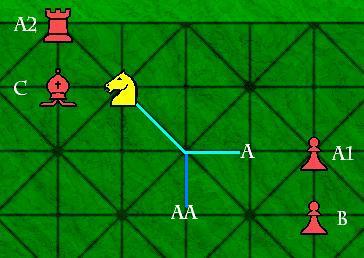
If the Yellow Knight moves to A, Yellow has the choice of capturing either the Red Pawn at A1 by approach or the Red Rook at A2 by withdrawal. If the Yellow Knight moves to AA instead, it simply captures the Red Rook at A2 by withdrawal, since it doesn't then approach any pieces. The Knight may not capture the opposing pieces at either B or C since it can not either move directly away from, or directly toward either of them. Actually, Knights may never capture pieces that are not on spaces with diagonal lines, as the topology of the board doesn't allow for it.
Alternate Setup
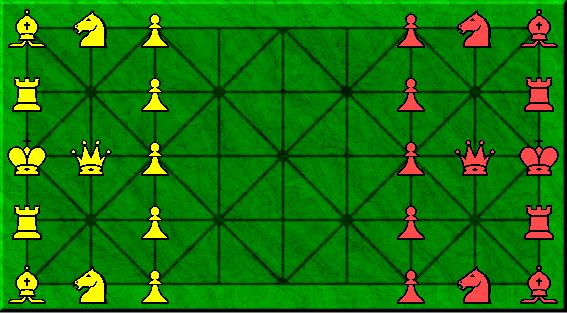
Yellow pieces occupy the first row, and are ordered: Bishop, Rook, King, Rook, Bishop. On the second row, there are more Yellow pieces, ordered Knight, empty space, Queen, another empty space, Knight. Yellow Pawns occupy all of the third row. Red pieces occupy the ninth and eighth rows in the same order as the Yellow pieces occupy the first and second rows and Red pawns occupy the seventh row.
This setup allows all of the pieces to move on the first turn, but in play testing seemed inferior to the first setup, as the increased ease of development effectively reduced the number of reasonable plays.
Double Fanorona Chess
Double Fanorona Chess is an enlarged version of Fanorona Chess played on the same quadruple Alquerque board used for Chesquerque, that adds another type of piece -- the Chancellor -- and Pawn initial double moves.Double Fanorona Chess Board and Setup
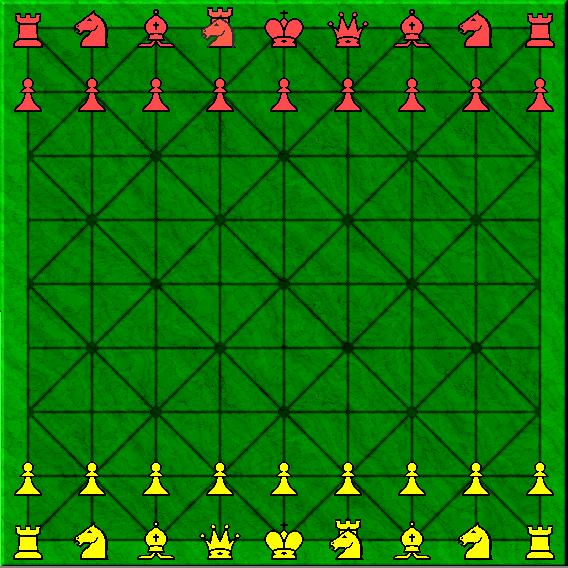
The board is 9x9 with only every other square (a1, a3, a5, a7, a9, b2, b4, etc.) having diagonal connectivity. Yellow pieces occupy the first row, and are ordered: Rook, Knight, Bishop, Queen, King, Chancellor, Bishop, Knight, Rook. Yellow Pawns occupy the second row. Red pieces occpy the ninth row in the same order as the Yellow pieces occupy the first, except that the Queen and Chancellor are switched, and Red pawns occupy the eighth row.
Movement of Pieces in Double Fanorona Chess
The pieces in Double Fanorona Chess move just as they do in regular Fanorona Chess with the exception of the Pawn and the addition of the Chancellor.The Chancellor moves like either a Rook or a Knight.
In addition to their normal moves Pawns may move two spaces straight ahead on their first move, but the move must be noncapturing. Thus, the Yellow Pawn starting on a2 may move to a4 on its starting move only if a3 and a4 are empty, and neither a1 nor a5 contain Red pieces. (There is still no en passant capture.)
Notes
This game came out of the 44-square contest, as I considered the double Alquerque board briefly, but rejected it as it has 45 squares, and I didn't think removing the center square would be a good idea. But I liked the idea of using that board, so I returned to it after I finished my contest entries.The first version of this game used replacement capture -- essentially, it was more or less Orthochess played on a Fanorona board. (The current setup comes from that design, where it ensured all of the Pawns were guarded.) However, with the narrow and limited board, the replacement capture version was just a dull exchange-fest. However, using the capturing methods from Fanorona seemed to give the game a more open, energetic feel. Double-Ended Chess is another variant of mine that uses these forms of capture.
The game is highly tactical in a lot of ways. The type of space a piece is on is very important, as Pawns, Queens and Kings are stronger on spaces with diagonal connections (having more moves and captures), but spaces without diagonal connections are safe from attack by both Bishops and Knights.
Thanks to John Lawson and David Howe for playtesting and suggestions.
Computer Play
There is an implementation of Fanorona Chess for Zillions of Games, and there is a link in the Also See section at the bottom of the page. Included in the ZIP archive is the ZRF for Double Fanorona Chess as well.
Written by Peter Aronson.
WWW page created: September 19th, 2004.
